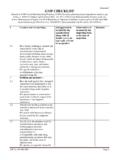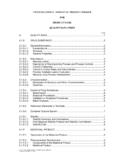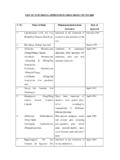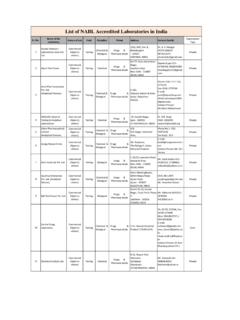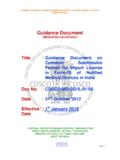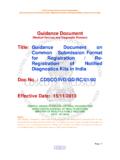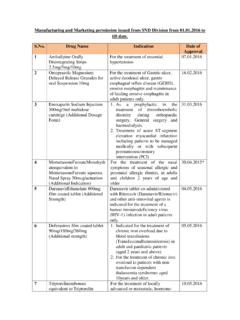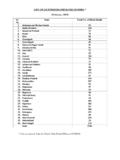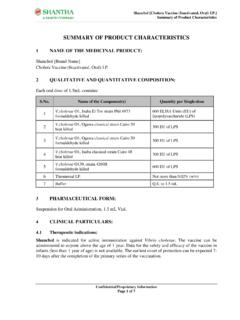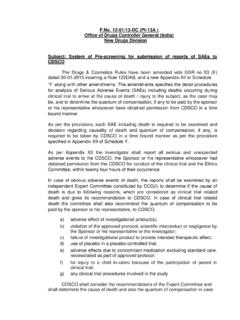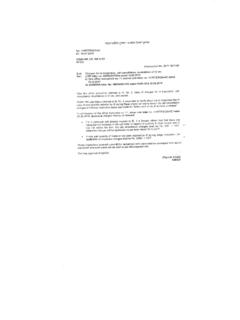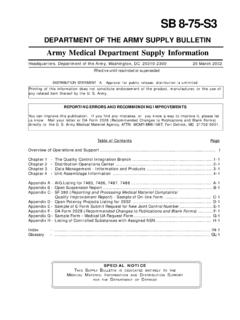Transcription of GUIDELINES ON RECALL AND RAPID ALERT SYSTEM …
1 GUIDELINES ON RECALL AND RAPID ALERT SYSTEM FOR DRUGS (Including Biologicals & Vaccines) Document No : CDSCO/RRAS Ver. : 00 Effective Date : 23/11/2012 Central Drugs Standard Control Organisation Directorate General of Health Services, Ministry of Health and Family Welfare, Government of India FDA Bhawan, ITO, Kotla Road, New Delhi -110002. TABLE OF CONTENTS Introduction 1 Background 1 Scope 1 Definitions 2 RECALL Classification 3 RECALL Procedures 3 Voluntary RECALL 4 Statutory RECALL 4 Level of RECALL 5 Time Lines for Effective RECALL SYSTEM & RAPID ALERT 5 Procedure for RAPID ALERT & RECALL SYSTEM 6 Overview of Process Flow RAPID ALERT & RECALL SYSTEM 8 Stepwise RECALL Procedure 9 Follow-up Action of Recalled Goods 10 Mock RECALL 12 Abbreviations 12 References 13 Page 1 of 13 Introduction: RECALL is an action taken to withdraw/remove the drugs from distribution or use including corrective action for which deficiencies are reported in quality, efficacy or safety.
2 The defective products related to quality includes Not of Standard Quality, Adulterated or Spurious drugs. Safety and efficacy related recalls include serious adverse reactions and death. Recalls also include drugs prohibited under the Provisions of Drugs & Cosmetics Act and also those products for which product licenses are suspended/cancelled. RAPID ALERT SYSTEM is to transmit only those alerts whose urgency and seriousness cannot permit any delay in transmission. Assessment must be made of the seriousness of the defect, its potential for causing harm to the patient or harm to animals (in case of veterinary product), consumers, operators and the environment. Background: In the Drugs & Cosmetics Act & Rules, there are references for product recalls, complaint and adverse reactions in Para 27 & 28 of Schedule M and also conditions of license for defective product RECALL in Rule 74(j) and Rule 78(i), but effective and uniform RECALL procedure, with time lines at every level of supply chain is required and at present auditing and accountability is not in place.
3 This has been observed in instances where drugs declared as not of standard quality by Government Analyst, incidents where serious adverse effects or death have been reported, in case of banned drugs under Section 26 A, defects where in voluntarily the manufacturer withdraws drugs from the market etc. Scope: These GUIDELINES is applicable to all quality defective product reports and to all reported incidents of safety and efficacy received for all drugs including vaccines & biological. These GUIDELINES are expected to be followed by licensees (manufacturers, importers, stockists, distributors, retailers) and the RECALL could be voluntary or statutory. The procedure may also be used by Drugs Control Authorities of Central or State when urgent action is required to protect public or animal health. These GUIDELINES would help in adopting to Page 2 of 13 stepwise procedures to be followed in RECALL strategy and also help in RECALL evaluation at every level and achieve compliance within the time frame.
4 Definitions: RECALL : Removal or correction of marketed products for the reasons relating to deficiencies in quality, safety or efficacy, including labeling considered to be in violation of the laws. Batch RECALL : Process for removal of selected batch/es of a product which are found to be defective and pose health risk to the consumers if left in the market. Batch (Lot): A specific quantity of material produced in a process or series of processes so that it is expected to be homogeneous within specified limits. Customer: Any person, firm or party buying/receiving goods from the company for storage, distribution and sale. Voluntary RECALL : A RECALL initiated by the licensee (in case of loan licensee jointly the contract giver and contract acceptor) as a result of abnormal observation in any product quality during periodic review (Internal / External) or investigation of a market complaint or any other failures.
5 Statutory RECALL : A RECALL directed by Drug Control Authorities after notifying that product is considered to be in violation of the laws. , Declared as Not of Standard Quality by Government Analyst and Banned under 26A of Drugs and Cosmetics Act 1940 (as amended from time to time)and as well as contravention of Rule 104-A of Drugs & Cosmetics Rules1945( as amended from time to time) Page 3 of 13 RECALL Classification: RECALL classification is a numerical designation, I, II, or III, that is assigned to a particular product RECALL that indicates the relative degree of health hazard by country regulatory authorities. In case of not of standard quality drugs, the recommendations of 39th DCC GUIDELINES for category A,B and C may be accordingly adopted for Class I, Class II and Class III until further recommendations if any. All banned Drugs & Products for which license is suspended, cancelled which are in circulation in market shall also be considered to be Class I recalls only.
6 Class I is a situation in which there is a reasonable probability that the use of, or exposure to, a defective product will cause serious adverse health consequences or death and as well as banned under 26A of Drugs and Cosmetics Act 1940. Class II is situation in which the use of, or exposure to, a defective product may cause temporary adverse health consequences or where the probability of serious adverse health consequences is remote. Class III is a situation in which the use of, or exposure to, a defective product is not likely to cause any adverse health consequences. RECALL Procedures: Any batch of a product not meeting the defined quality standards has to be recalled from the market. RECALL can be of two types; Voluntary RECALL and Statutory RECALL . Page 4 of 13 Voluntary RECALL : Voluntary RECALL can be triggered by any incident that affects the quality, safety and efficacy of the batch/product in question such as 1.
7 If the batch or batches are found to be not complying with the regulatory specifications during the post marketing stability study 2. If the batch is found to be defective during investigation of market complaint. 3. During any failure investigation, if it is observed that the failure under investigation might have adverse quality impact on already released batch ( possibility of contamination, mix-up, degradation etc). 4. If any unusual observation is noted during visual inspection of retention samples which indicate an impact on quality of the product after investigation. 5. If the post marketing surveillance reports /pharmacovigilance reports indicates that there is serious safety risk associated with the product. Statutory RECALL : Statutory RECALL can be triggered in response to the direction or mandate by the Drug Regulatory Authorities (Central/State) in one or more of the situations as follows : 1.
8 To RECALL the drug product/batch, considered to be in violation of the laws, it administers such as not of standard quality etc. 2. To RECALL the banned drugs. 3. Labeling and / or Promotional materials, that are considered to be in violation of law. 4. Product, violation Rule 106 (Diseases under Schedule J) Page 5 of 13 Levels of RECALL : The level (or depth) of RECALL of a product/batch shall be determined based on RECALL classification and level to which distribution has taken place. There are three levels of RECALL such as consumer/user, retail and wholesale. Consumer or User Level: which may vary with product, including any intermediate wholesale or retail level. Consumer or user may include individual consumers, patients, physicians and hospitals. Retail Level:- RECALL to the level immediately preceding consumer or user level.
9 It includes retail groceries, pharmacies, hospital pharmacies, dispensing physician, institutions such as clinics and nursing homes, etc. Wholesale Level: all distribution levels between the manufacturer and retailer. All Class I recalls shall be executed to the levels of Wholesale/Distributors, retail, and consumer. In such cases, public announcements shall be made using print/electronic media aids viz. Newspapers, Television, Radio etc. All Class II recalls shall be executed up to the levels of wholesale and retail. All Class III recalls shall be executed up to the levels of wholesale. Time Lines for Effective RECALL SYSTEM & RAPID ALERT : Based on the category of risks involved, a time line of within 24 hours up to a maximum of 72 hours for Class I RECALL , for class II RECALL up to a maximum of 10 days and for Class III RECALL up to a maximum of 30 days is allowed.
10 Page 6 of 13 The time line for initiation of RECALL procedure to commence from the receipt of information as notified by the concerned State/ Central Drugs Control Department under statutory RECALL or voluntary RECALL by the manufacturer on its own. The RECALL has to be initiated immediately without any prejudice of the outcome of Section 25(3) and Section 25(4) of the Drugs & Cosmetics Act 1940 for adducing the evidence. The time line for stopping sale/distribution of defective product under Class I shall be ensured within 24 hours and the physical RECALL being completed within 72 hours. The Class II and Class III recalls shall be ensured upto 10 and upto 30 days respectively. Procedure for RAPID ALERT & RECALL SYSTEM : As soon as the product/batch(es) to be recalled is/are identified, licensee or representative of licensee or QA in charge shall review the information related to the defective product/batch(es) and decide about RECALL as per the procedure established.
